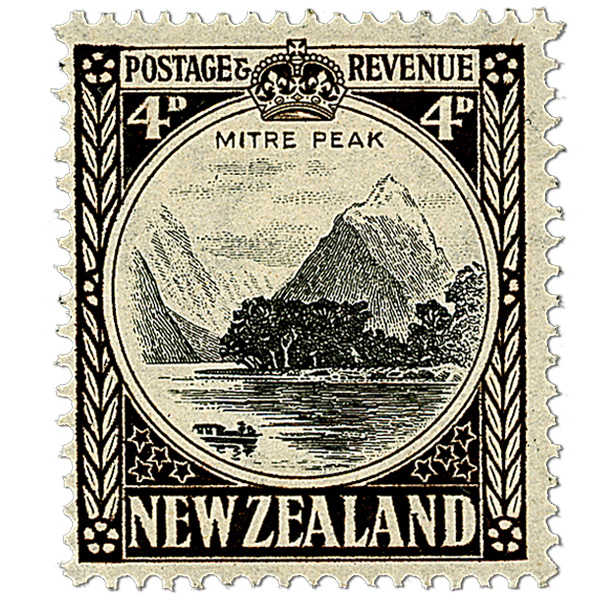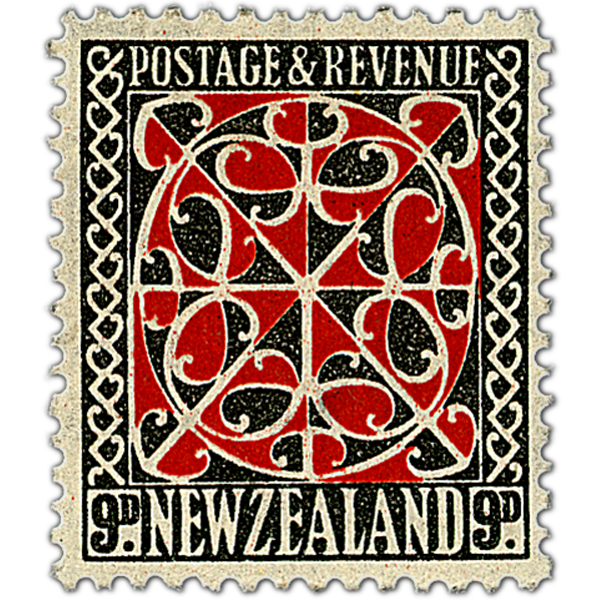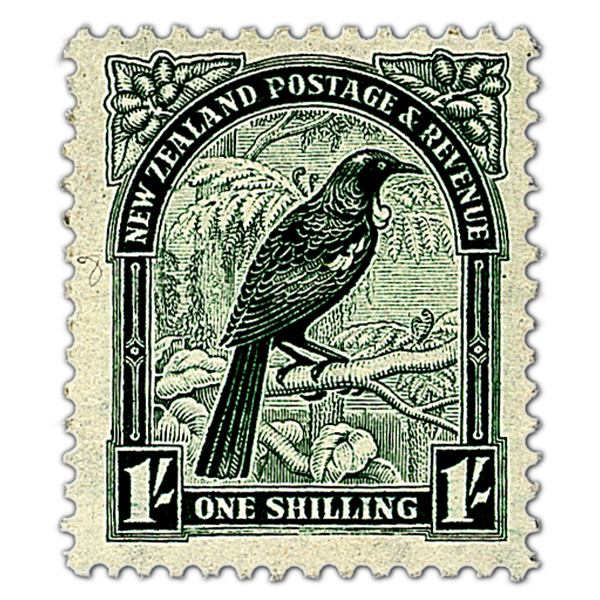By 1931 several of the plates that had been used to produce the King George V stamps were becoming worn. It was thought that as the King's portrait had been used for sixteen years there would be no objection to the introduction of a new pictorial issue. Cabinet approved the proposal and as a public competition had proved so popular for the 1898 issue it was decided to arrange a similar competition on this occasion.
Issue information
Entries were divided into subject groups and it was agreed that there should be three depicting New Zealand fauna, three representing scenery, three devoted to Māori subjects, two presenting agricultural and pastoral scenes, and one each portraying an historical subject, sport and Māori art.
The 1/2d and 4d stamps were designed by J Fitzgerald, the 1d by C H & R J G Collins, the 1 1/2d by M Matthews, the 2d by H W Young, the 2 1/2d, 3d, 8d and 3s by L C Mitchell, the 5d by R E Tripe and W J Cooch, the 6d by T I Archer, the 9d by I F Calder, the 1s by M King and the 2s by T H Jenkins.
The 9d value was originally surface printed by Waterlow & Sons then later by the New Zealand Government Printer. The other values in the issue were recess printed by Thomas De La Rue until 1941 when for a period of time (due to war conditions) the printing and perforation of the stamps was a matter of co-operation between Thomas De La Rue, Waterlow & Sons and Harrison & Sons (who perforated one value printed by De La Rue).
Acknowledgments
New Zealand Post would like to acknowledge the following for their assistance and guidance in bringing together this stamp issue:
Historical information included on this page sourced from The Postage Stamps of New Zealand published by the Royal Philatelic Society of NZ. Their web site offers further information useful to those interested in the stamps and postal history of New Zealand. Link: https://www.rpsnz.org.nz/
Product Listing for 1935 Pictorials
| Image | Title | Description | Price |
|---|---|---|---|
 |
Single Stamp |
Single 1/2d 'Fantail' gummed stamp. The fantail or 'pīwakawaka' in Māori, is a very sociable New Zealand native. The bird's name derives from its beautiful tail of twelve feathers, which broadly expands as the bird flits about. In the background of the design is one of the best-known flowers of the New Zealand bush, the beautiful clematis, which is particularly appropriate, as both the bird and the flower are usually found near the edge of the forest. |
1/2d |
 |
Single Stamp |
Single 1d 'Kiwi' gummed stamp. New Zealand has more varieties of flightless birds than any other country, and the kiwi is one. The bird is unique in that its nostrils are placed at the extreme end of its beak and its nasal passage is more complicated than that of any other bird. Although most bird's sense of smell is usually small, that of the kiwi's is high. It is nocturnal with its habits, issues a loud whistling cry, and sniffs audibly when hunting food. Cabbage palm on left. |
1d |
 |
Single Stamp |
Single 1 1/2d 'Māori Woman Cooking Food' gummed stamp. This stamp depicts a young Māori woman lowering into a boiling spring a 'kete' of food for cooking. A 'kete' is a basket plaited from flax. |
1 1/2d |
 |
Single Stamp |
Single 2d 'Māori Meeting House' gummed stamp. Upon arrival in New Zealand the Māori found they needed warmth and protection from the wind and rain, unlike the tropical islands from which they had come. They developed the style of large, rectangular meeting houses made from wooden planks with thatched, gabled roofs and doors recessed behind deep verandas. Their living quarters or 'whare' were built in a similar but smaller style, the houses reflecting their communal living style. The functions of cooking and food storage were kept separate from the 'whare'. Tree-fern on left, cabbage palm to right. |
2d |
 |
Single Stamp |
Single 2 1/2d 'Mount Cook' gummed stamp. Mount Cook is the highest mountain in New Zealand. The early Māori immigrants in the Araiteuru canoe named the mountain 'Aorangi' after their Chief's grandson. The lily (Ranunculus lyallii) depicted on the border of the stamp is one of the most distinctive of New Zealand 's alpine flora. It grows only on the high mountains of the South Island. |
2 1/2d |
 |
Single Stamp |
Single 3d 'Wāhine (Young Māori Girl)' gummed stamp. The young Māori girl is illustrated wearing a 'pare', or head-band of plaited flax, dyed red and black, or left the natural colour of the dried silky fibre. In her hair is a feather of a huia, a native bird now extinct. Suspended by a flax cord fastened around her neck is the characteristic Māori amulet - 'tiki". |
3d |
 |
Single Stamp |
Single 4d 'Mitre Peak' gummed stamp. One of the most outstanding of the many wonderful scenes to be found in the picturesque Fiordland of the South Island is illustrated on this stamp. Mitre Peak (1,695 metres) stands at the head of Milford Sound. The ti-tree (manuka) fills the borders of the stamp, and the four stars in each of the lower corners suggest the Southern Cross. |
4d |
 |
Single Stamp |
Single 5d 'Swordfish' gummed stamp. This stamp depicts a striped marlin sword-fish, one of several species of big-game fish to be found in New Zealand waters, leaping from the water after being hooked. The rock on the left is Piercy Island, near Cape Brett, a famous fishing-ground for sword-fish and the fierce mako shark. |
5d |
 |
Single Stamp |
Single 6d 'Harvest - The Reaper' gummed stamp. This design illustrates the harvesting of a crop of wheat or oats. |
6d |
 |
Single Stamp |
Single 8d 'Tuatara' gummed stamp. The tuatara is a link between the lizard and the crocodile, and is the sole living representative of some of the oldest creatures that ever inhabited the earth - evidence of the great antiquity of New Zealand. The tuatara is peculiar in having the relic of a third eye. It is 30 - 45 centimetres in length, covered with a grey, leathery, wrinkled skin. |
8d |
 |
Single Stamp |
Single 9d 'Māori Decoration' gummed stamp. The subject of this stamp is a modification of a design adopted by the Māori for the ornamentation of sliding panels used as doors, 'tatau', employing the preferred colours of red, black and white. The initial printing of this stamp by Waterlow & Sons was in black and red, subsequent printings by the New Zealand Government printer resulted in many colour variations from slate-grey to black and red to scarlet. |
9d |
 |
Single Stamp |
Single 1s 'Tui' gummed stamp. A number of New Zealand birds are songless, but the beautiful tui is a notable exception. It is an inimitable songster, a remarkable mimic, and it can be taught to talk. Between 30 and 38 centimetres in length, the tui has two tufts of white feathers at its throat, a collar of long white curved feathers on the back of its neck, and a touch of white on the angle of its wings. Its body is in two shades of brown, and its wings and neck feathers are iridescent, gleaming green or blue according to the play of light on the feathers. |
1s |
 |
Single Stamp |
Single 2s 'Landing of Captain Cook' gummed stamp. Captain James Cook landed at Poverty Bay on 8 October 1769, during his first voyage in the Pacific. Poverty Bay was so named because of the unwelcome reception accorded to the explorers by the local natives and their resulting inability to obtain provisions. |
2s |
 |
Single Stamp |
Single 3s 'Mount Egmont/Taranaki' gummed stamp. This isolated volcanic mountain has a beautiful symmetric cone and reaches 2,518 metres. Egmont was named in 1770 by explorer James Cook as he sailed past but the Māori name Taranaki (Barren Mountain) was given equal and official status in 1986. |
3s |
Technical information
| Date of issue: | 1 May 1935 |
|---|---|
| Designers: | J Fitzgerald, Christchurch; C H & R J G Collins, Christchurch; M Matthews, Wellington; H W Young, Auckland; L C Mitchell, Wellington; R E Tripe & W J Cooch, Wellington; T I Archer, Nasik, India; I F Calder, Wellington; M King, Wellington and T H Jenkins, Invercargill |
| Printers: | Thomas De La Rue, England; Government Printing Office, New Zealand and Waterlow and Sons, England |
| Stamp size: | 1/2d, 1d, 1 1/2d, 2d, 3d, 9d (earlier printings) and 1s : 21mm x 24mm; 2 1/2d, 5d, 2s and 3s: 40.5mm x 24mm; 4d and 8d : 25mm x 29mm; 6d : 29mm x 25mm; 9d (later printings): 17.5mm x 20.5mm |
| Sheet size: | 1/2d, 1d, 1 1/2d, 2d, 3d, 9d and 1s: 240 stamps per sheet (one print of 9d : 120 stamps per sheet); 2 1/2d and 3s: 60 stamps per sheet; 4d: 80 stamps per sheet; 5d and 2s: 120 stamps per sheet; 6d and 8d: 160 stamps per sheet; Booklets containing 1d stamps; Coils of 2d, 5d, 6d, 8d and 1s stamps |
| Process: | Recess printed - Intaglio; 9d: Surface printed - Typography |
| Perforation gauge: | Several variations |
| Paper type: | Various, with single or multiple NZ and star watermark. |






